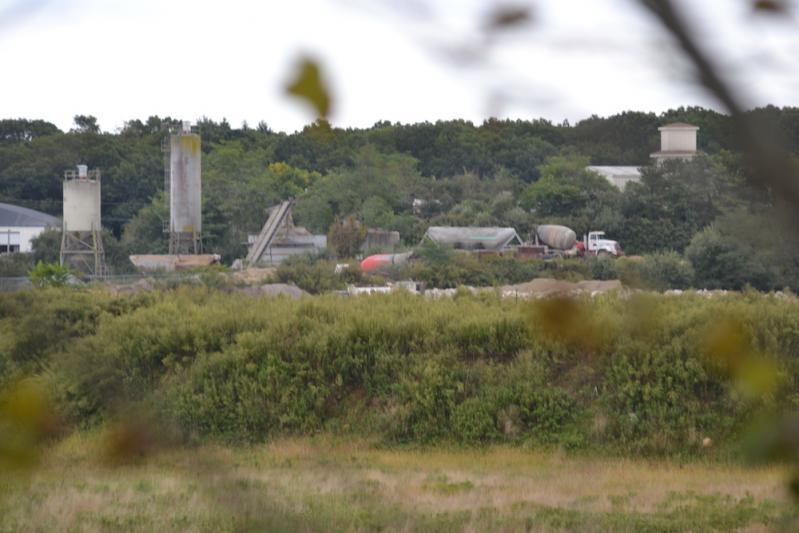An outside counsel retained by East Hampton Town has questioned the State Department of Environmental Conservation's conclusion that a former sand and gravel pit in Wainscott should not be included on its Registry of Inactive Hazardous Waste Disposal Sites, commonly called Superfund sites, despite high levels of perfluorinated chemicals (PFAS) in soil and groundwater.
Addressing the town board on Tuesday, Nicholas Rigano pushed back at the D.E.C.'s classification of the pit as an "N" site, meaning it will not be designated a Superfund site, despite soil and groundwater samples showing high levels of both perfluorooctanesulfonic acid (PFOS) and perfluorooctanoic acid (PFOA). The agency had previously classified it as a 'P' site, for potential Superfund designation.
Both acids are used in a variety of consumer and industrial applications, notably aqueous film-forming foam, a fire suppressant that was regularly used to extinguish fires involving fuel. Consequently, PFAS contamination has been detected at airports, fire-training areas, and military bases around the country.
Last year, the D.E.C. added 47 of 570 acres at the adjacent East Hampton Airport to its Superfund sites based on detections of PFAS in soil and water tests. At the former sand and gravel pit site, however, the agency concluded that "the highest PFAS groundwater detections were in up-gradient and side-gradient monitoring wells, indicating that the contamination is coming from an off-site source," says Mr. Rigano's report, and that low-level PFAS detections in the soil "do not implicate the site as a contributing source of PFAS groundwater contamination."
PFAS and PFOA have been designated as hazardous substances under state law. "Very, very low concentrations are considered toxic," Mr. Rigano told the town board. In July, Gov. Andrew M. Cuomo announced maximum contaminant levels for PFOS and PFOA, which are considered emerging contaminants, of 10 parts per trillion, well under the federal Environmental Protection Agency's current guidance of 70 ppt. Drinking-water standards are used as a groundwater cleanup standard under state law.
"Typically, soil contamination is the key" to determining if a site is the source of water contamination, Mr. Rigano said, as soil does not flow on or off a site as groundwater does.
The D.E.C.'s sampling protocol provides that further assessment should be conducted if levels of PFOA or PFOS exceed 10 ppt, if levels of any PFAS compound are detected above 100 ppt, or if the total concentration of PFAS is detected above 500 ppt.
The D.E.C. designated the sand pit a "P" site last year after a consultant for the pit detected PFOS and PFOA in groundwater; because operations at the site have consisted of suspect PFAS contamination, and because media reports from 2000 detailed fire departments conducting a training exercise with fire suppression foam at the northern part of the property. The D.E.C. released a site characterization report in July.
Multiple soil borings at the northern end of the site revealed PFOS up to 3.01 parts per billion, "comparable to what was detected at the airport," Mr. Rigano said. Groundwater contamination at the same location was detected at 151 ppt of PFOS, 2,850 ppt of PFNA, another PFAS compound, and total PFAS "in excess of 3,000 parts per trillion." PFAS was detected in groundwater throughout the site, he said, with the highest levels found at the western border -- PFOS up to 1,010 ppt and PFAS up to 1,533 ppt.
In its preliminary assessment, the D.E.C. relied on regional groundwater flow models that suggest a southeasterly flow, Mr. Rigano said. The agency did not determine a site-specific groundwater flow. "Groundwater does fluctuate," the consultant said, "especially in East Hampton, where tidal flow could impact the direction in which groundwater does flow at a specific site and time."
Despite high PFAS levels in groundwater and photographic evidence of the use of fire suppressant at the site, the D.E.C. did not add it to its Superfund registry. "Why?" Mr. Rigano asked. "Their conclusion is because the highest groundwater detections were up-gradient and side-gradient -Ð up and side-stream at the property. The groundwater appears to be flowing on to the property, and not from the property. They say the low level of PFAS detections do not implicate the site as a contributing source of PFAS groundwater contamination." The agency may be right, he allowed, but added that fire training activity suggested itself as a contributing source.
Whether the site is or isn't a source of PFAS contamination "is subject to further review by other parties," Mr. Rigano said, as the D.E.C. did not make a conclusive determination. But "here, we have soil contamination and a photo showing activity, so there is reason to believe this site is a source."
"Soup to nuts, this will likely cost millions of dollars" to investigate and remediate, Mr. Rigano said. The town has sued East Hampton Village, "d/b/a/ East Hampton Fire Department," and its liability insurance company over the PFAS stored and used at the airport, as well as the manufacturers of the chemicals and firefighting foam. The town owns the land on which the airport, on Daniel's Hole Road, and the Lawrence Franzone Fire Training Facility, on Industrial Road, are situated, but, the complaint notes, the village owns and operates the fire department, which the town claims caused contamination by storing and using A.F.F.F. there. The fire department maintains a substation at 72 Industrial Road, land also owned by the town.
"I guess I'm surprised that there's not more investigation as to groundwater flow at this specific site," Supervisor Peter Van Scoyoc said at the conclusion of Mr. Rigano's presentation, "especially with determining where the contamination might have originated from."




